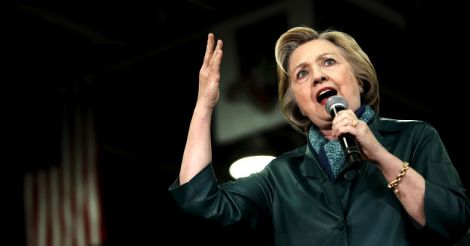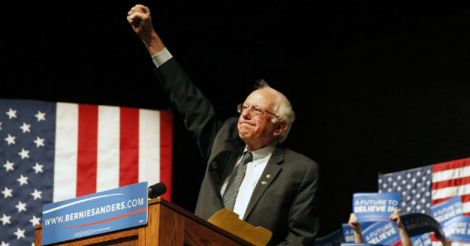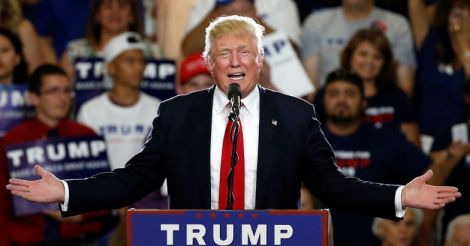Donald Trump has dominated discussions in the media and most drawing rooms because of his incendiary comments. However, beyond the headlines of these comments, most of Donald Trump’s positions are not very different from the far leaning socialist candidate in the Democrat party Bernie Sanders, who has vowed to fight for the nomination with frontrunner Hillary Clinton till the Democratic Party convention. Donald Trump and Bernie Sanders have similar positions on wage inequality, trade agreements, outsourcing and Wall Street bashing. This left leaning position of Bernie Sanders has also forced Hillary Clinton, a centrist and previously a backer of trade agreements such as NAFTA (North American Free Trade Agreement), to now also take a protectionist stance somewhat similar to Bernie Sanders and Donald Trump.
The primary difference between the far left Democrats & Trumpian philosophy is on immigration. Both parties view the issue of immigration from an economic lens. Republicans in southern states such as Arizona view immigration as a potential question of fewer jobs available to local US citizens, which acts as a dampening effect on the US wages. Democrats, who have overwhelming support among Hispanics, have a more nuanced approach to immigration primarily for political reasons. Bulk of immigrants, who have got American citizenship in the last two decades, are voters of the Democratic Party.
The US economy relative to Europe and the emerging markets has been growing. Macro-economic indicators such as inflation at 1.1% and unemployment rate at 4.9% are strong and favorable. However, many Americans feel left-out from the country’s prosperity. The median wage in the US has been stagnant over the past several decades, while the gulf between the richest and poorest classes has been growing. This stagnation among the middle classes and blue collars is resonating among both Donald Trump & Bernie Sanders supporters. Both Sanders & Trump, who have tough messages on outsourcing to countries such as Mexico, China and even India, have won resoundingly among young white voters who are without college degrees, and among blue collar and working class people.
 US presidential candidate Hillary Clinton (file photo)
US presidential candidate Hillary Clinton (file photo)President Barack Obama who came to power when the United States was hit by the 2008 economic meltdown has been much more global in his economic policies. He has argued for newer trade treaties, has permitted more foreign students who graduate in the STEM (science, Technology, Engineering and Mathematics) to spend an extra year in the country, to find work and pursue research. He has also opposed the moves to reduce long-term employment visas under H1B category for skilled workers. Now the country issues 65,000 visas, which benefits a large number of Indian students, who pursue graduate and post graduate degrees in the United States. But Obama has also pushed hard for American students to pursue degrees in science and mathematics, and has made affordable college education a major pillar of his education policy. Democratic frontrunner Hillary Clinton has promised a large degree of continuity of the economic and foreign policies of Obama, though she has emphasised more support to working men and women, as well as for children.
 US presidential candidate Bernie Sanders (file photo)
US presidential candidate Bernie Sanders (file photo)Some of the political messages of Trump and Sanders directly conflict with how America became the largest rich country in the world. For instance, the immigration policy, which has been much criticized by American politicians has been a key contributor to the American growth story. An open immigration policy has over the last century helped develop technology centers such as Silicon Valley, contributed to developing the world’s best universities, and has created much to the diversity seen in cities such as New York and San-Francisco. With immigration comes high paying jobs and tax collection, which in turn leads to government spending and riches. Enforcing a stricter immigration policy through reducing the number of H1B visas, increasing the resultant costs of visas and requiring students to leave the country after their higher studies can threaten economic progress itself. Colleges will not fill their seats and there are too few skilled Americans to meet the demands of high-skilled jobs.
While the politicians of today plan to curtail immigration, they also want to stop outsourcing of manufacturing and service jobs to low-cost countries. Most large US corporations across sectors such as technology and manufacturing have developed large offshore centers outside the US over the last 2-3 decades. A few foreign technology companies such as IBM, Oracle and Accenture each employ around 1 lakh persons in their centers in India. The campaign trails have witnessed promises to return these jobs to the US and to penalize companies that outsource to developing countries. This trend will be difficult to reverse given the significant economic benefits that US companies obtain with outsourcing. For example, as per some estimates, the development of a drug in the US can take over 10 years with a cost of over US$ 2.5 billion. Often it is cheaper and more efficient to perform these activities elsewhere.
 President Barack Obama, who came to power when the United States, was hit by the 2008 economic meltdown has been much more global in his economic policies.
President Barack Obama, who came to power when the United States, was hit by the 2008 economic meltdown has been much more global in his economic policies.While companies need outsourcing to be competitive in the US, the highest value functions are performed in the US and the profit associated with such functions are retained in the US. Take the example of the Apple i-Phone. While it costs a little over US$ 200 to make an iPhone 6s, it retails at about 3 times the cost and such profits all vest in the US. While the lower-end functions such as manufacturing are performed in countries such as Taiwan and China, the intellectual property and design features have been mostly developed in the US. This trend has seen American companies become ever so profitable. US industry earns more than US$300 billion a year through outsourcing, though now many technology firms in India are also taking advantage of the investment climate to set up technology centers in the United States and give employment to American citizens.
Global trade arrangements where each country focuses on their respective strengths and partner together to deliver the highest quality product at the lowest cost to customers is rooted in years of economic comparative advantage theory. The populist messages of Donald Trump and Hillary Clinton risk going against proven economic theories, which could spark a global trade war, and make consumers all over the world worse off.

























 US presidential candidate Donald Trump (file photo)
US presidential candidate Donald Trump (file photo)